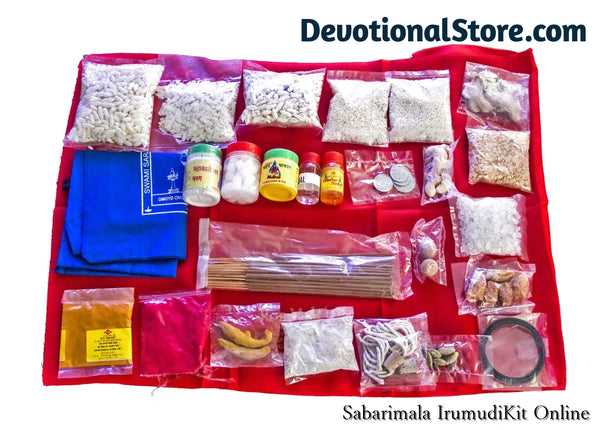Irumudi kettu is a travel pouch or a travel kit of the Sabarimala pilgrims. Irumudi kettu is a small bag with two compartments one in the front and another in the back that has to be filled with Pooja items. The front compartment of the bag is called munmudi and back compartment of the bag is called pinmudi, the front portion (munmudi) is for Lord Ayyappa and the back portion (pinmudi ) is for carrying the personal belongings of the devotee.
The term Iru means two and Kettu means knot or a small bundle. Irumudi kettu is the most important component of pilgrimage to Sabarimala. The irumudikettu is prepared under the surveillance of Guruswami and preparing irumudi kettu is known as kettu nirakkal or palli kettu. The irumudi kettu is carried by devotees who have observed 41 days vritham. Irumudi kettu is essential to step the 18 steps that lead to the shrine of Lord Ayyappa. Devotees without Irumudi Kettu are not allowed to pass through the stairway to reach the shrine.
 What are the Essential Ingredients of Irumudi Kettu?
What are the Essential Ingredients of Irumudi Kettu?
Cleaned coconut to fillmghee
Currency coins (Kanni Ponnu )
Rose water
Malar (puffed rice)
Agarbathis (incense sticks)
Camphor Rice
Jaggery
Betel leaves
Avil (beaten rice)
Arecanut pieces
2 other coconuts
Turmeric powder
Sandal powder/paste
Vibhuthi
Pepper (for Vavar and the optional items like candy sugar, small quantity of honey, dry grapes
Towels,
Cloth to change and bed sheets are also carried by the pilgrim with the Irumudi.
Some of the items are optional like dry grape.
What does the Nei thenga (Ghee filled Coconut ) and the Nei Abhishekam Signifies?
The concept of Nei Thenga has a very higher spiritual meaning. The coconut carried to the shrine is considered as the representation of Human body, which has to be kept clean internally and externally. As part of external cleaning it has to be cleaned thoroughly and the fiber and all small particles around should be rubbed off and should be kept clean and smooth. It symbolizes the purity of devotees body.

Secondly, the coconut water is drained out through a small opening made on the end of the coconut. The draining of sweetened water symbolizes the cleansing of inner senses of sensual pleasure. It shows that the inner self of devotee is emptied and getting ready to get filled with pure life source. Filling the emptied coconut with ghee symbolizes this concept.
Nei Thenga or Mudra Thenga or Ghee coconut signifies purified devotee. Each Nei thenga signifies physically and spiritually cleansed devotee who is ready to surrender completely before Lord Ayyappa. The ghee is used for Abhishekam and the empty coconut is put to burn outside. It shows that the body perishes but the cleansed inner-self reaches the almighty.
It is only in Sabarimala the devotees and the God become the
one and the same. Sabarimala is an abode of spiritual awakening and enlightenment. Swami Saranam.

No comments:
Post a Comment